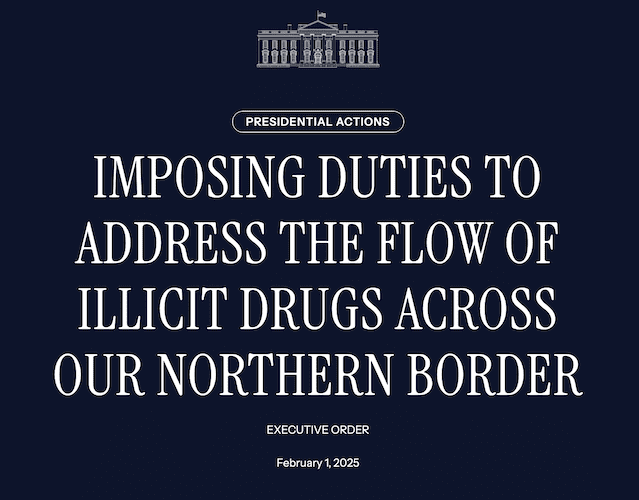
On February 1, 2025, President Donald Trump issued an executive order imposing significant tariffs on Canadian imports, citing drug trafficking and border security concerns. This analysis examines the order’s implications, its potentially harmful rhetoric, and provides concrete steps for Americans to prepare for and respond to its effects.
Understanding the Order’s Scope
The executive order implements two primary tariff levels:
- A 25% additional duty on most Canadian imports
- A reduced 10% duty on energy-related products
These tariffs take effect February 4, 2025, with limited exceptions for goods already in transit before February 1. The order frames these measures as a response to what it characterizes as Canada’s failure to adequately combat drug trafficking, particularly fentanyl, across the northern border.
Concerning Rhetoric and Claims
The executive order’s language raises several red flags that deserve careful scrutiny:
Inflammatory Language and Fear Mongering
The order employs strongly nationalistic and militaristic rhetoric, using phrases like “A Nation without borders is not a nation at all” and dramatic claims about national sovereignty being “eroded.” This type of language appears designed to create an atmosphere of crisis and fear rather than promote measured policy discussion.
Questionable Statistical Claims
The order makes a striking claim that fentanyl seized at the northern border “could kill 9.5 million Americans.” This figure requires careful scrutiny, as it appears to be an extrapolation based on theoretical lethality rather than actual risk assessment. While fentanyl is indeed dangerous, such dramatic figures risk oversimplifying a complex public health issue.
Scapegoating and Oversimplification
The document singles out Canada as bearing central responsibility for drug trafficking issues, despite acknowledging that Mexican cartels are the primary operators of the synthesis labs in question. This oversimplification of complex international criminal networks could hamper effective multilateral solutions.
Economic Impacts on Americans
The tariffs’ implementation will likely have significant consequences for American consumers and businesses:
Consumer Costs
With a 25% tariff on most Canadian goods, Americans should expect price increases on numerous products. Canada is a major supplier of:
- Agricultural products
- Lumber and building materials
- Automotive parts
- Manufacturing components
These increased costs will likely be passed on to consumers, affecting everything from grocery prices to housing costs.
Business Disruption
American businesses relying on Canadian suppliers or operating in cross-border supply chains will face immediate challenges:
- Higher input costs
- Supply chain disruption
- Potential retaliatory measures from Canada
- Uncertainty in business planning
Energy Markets
While energy products face a lower 10% tariff, this still represents a significant cost increase that could affect heating and fuel prices, particularly in northern states heavily dependent on Canadian energy imports.
Broader International Implications
The order’s aggressive stance toward Canada, traditionally one of America’s closest allies, signals a significant shift in international relations:
Diplomatic Strain
The order’s confrontational language and unilateral action risk damaging the historically strong U.S.-Canada relationship. This could affect cooperation on other crucial issues like:
- Intelligence sharing
- Military cooperation
- Environmental protection
- Trade in other sectors
Trade Agreement Concerns
The order may conflict with existing trade agreements, potentially triggering legal challenges and further international complications. This creates uncertainty for businesses and investors on both sides of the border.
Action Steps for Americans
For Consumers
- Audit Your Expenses
- Review your regular purchases to identify products likely to be affected by the tariffs
- Research alternative products or suppliers where possible
- Consider bulk purchasing essential items before price increases take effect
- Budget Adjustments
- Plan for potential price increases on everyday items
- Build an emergency fund if possible to handle increased costs
- Consider energy efficiency improvements to offset potential energy cost increases
- Stay Informed
- Monitor price changes in your area
- Keep track of which products are affected
- Watch for any exemptions or modifications to the tariffs
For Businesses
- Supply Chain Assessment
- Identify which of your inputs come from Canada
- Calculate the potential cost impact of the tariffs
- Research alternative suppliers
- Consider stockpiling essential materials if feasible
- Contract Review
- Examine existing contracts with Canadian suppliers
- Review force majeure clauses
- Consider renegotiating terms where possible
- Assess options for price adjustments with customers
- Strategic Planning
- Develop contingency plans for supply chain disruption
- Consider domestic sourcing alternatives
- Evaluate potential for automation or efficiency improvements
- Plan for possible Canadian retaliation
For Investors
- Portfolio Review
- Assess exposure to companies heavily dependent on U.S.-Canada trade
- Consider diversification strategies
- Watch for opportunities in domestic alternatives to Canadian imports
- Risk Management
- Review investment timeline and risk tolerance
- Consider hedging strategies where appropriate
- Monitor currency exchange rates and their impact
Civic Action Steps
- Contact Representatives
- Write to your congressional representatives about the impact of these tariffs
- Share specific examples of how the tariffs affect your community
- Request oversight hearings on the economic impact
- Community Organization
- Form or join local business groups to share information and resources
- Create community support networks to help affected individuals
- Document and share the local impact of the tariffs
- Public Comment
- Submit comments to relevant government agencies
- Share experiences with local media
- Participate in public forums on the issue
Looking Ahead
The executive order’s implementation bears careful watching, particularly for:
- Potential modifications or exemptions
- Canadian response and possible retaliation
- Legal challenges
- Economic impacts at local and national levels
The order’s connection of trade policy to drug enforcement represents a significant shift in approach that could have lasting implications for U.S. trade relationships and border policy.
Resources for Further Information
Government Resources
- U.S. Customs and Border Protection (for tariff implementation details)
- Department of Commerce (for trade impact analysis)
- State Department (for diplomatic updates)
Economic Information
- Federal Reserve Economic Data (FRED)
- Bureau of Labor Statistics (for price impact tracking)
- Industry-specific trade associations
Legal Resources
- Trade law specialists
- Business associations
- Consumer protection organizations
Conclusion
This executive order represents a significant shift in U.S.-Canada relations and trade policy, with potentially far-reaching consequences for American consumers, businesses, and communities. While the stated goal of combating drug trafficking is important, the order’s approach raises concerns about both its effectiveness and its economic impact on Americans.
The combination of aggressive rhetoric, dramatic claims, and broad economic measures requires careful scrutiny and proactive preparation by affected parties. By staying informed, planning ahead, and taking concrete steps to adapt, Americans can better navigate the challenges posed by these new tariffs while working through appropriate channels to address concerns about their implementation and impact.
Note: This analysis is based on the executive order as issued on February 1, 2025, and accompanying White House fact sheets. Developments after this date may affect its implementation or impact.

